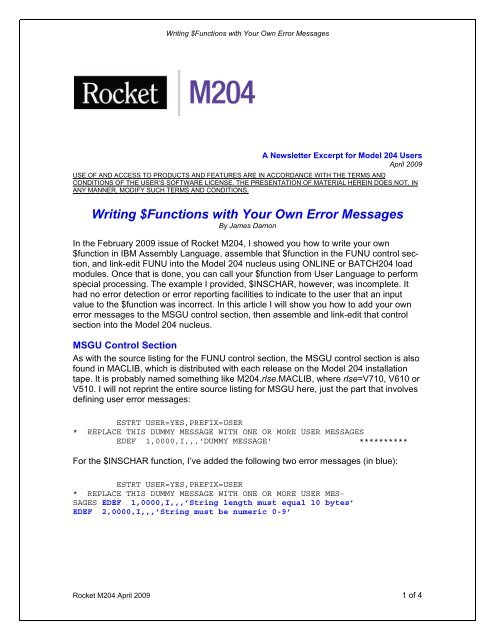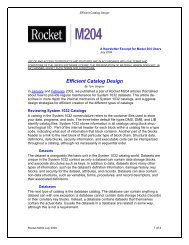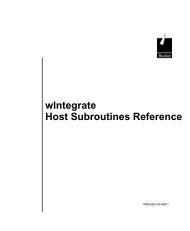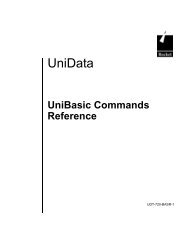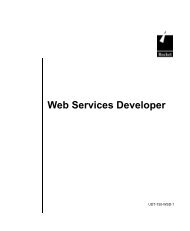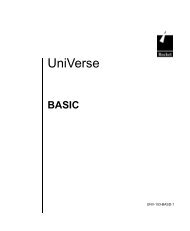Writing $Functions with Your Own Error Messages - Rocket Software
Writing $Functions with Your Own Error Messages - Rocket Software
Writing $Functions with Your Own Error Messages - Rocket Software
You also want an ePaper? Increase the reach of your titles
YUMPU automatically turns print PDFs into web optimized ePapers that Google loves.
<strong>Writing</strong> <strong>$Functions</strong> <strong>with</strong> <strong>Your</strong> <strong>Own</strong> <strong>Error</strong> <strong>Messages</strong><br />
A Newsletter Excerpt for Model 204 Users<br />
April 2009<br />
USE OF AND ACCESS TO PRODUCTS AND FEATURES ARE IN ACCORDANCE WITH THE TERMS AND<br />
CONDITIONS OF THE USER’S SOFTWARE LICENSE. THE PRESENTATION OF MATERIAL HEREIN DOES NOT, IN<br />
ANY MANNER, MODIFY SUCH TERMS AND CONDITIONS.<br />
<strong>Writing</strong> <strong>$Functions</strong> <strong>with</strong> <strong>Your</strong> <strong>Own</strong> <strong>Error</strong> <strong>Messages</strong><br />
By James Damon<br />
In the February 2009 issue of <strong>Rocket</strong> M204, I showed you how to write your own<br />
$function in IBM Assembly Language, assemble that $function in the FUNU control section,<br />
and link-edit FUNU into the Model 204 nucleus using ONLINE or BATCH204 load<br />
modules. Once that is done, you can call your $function from User Language to perform<br />
special processing. The example I provided, $INSCHAR, however, was incomplete. It<br />
had no error detection or error reporting facilities to indicate to the user that an input<br />
value to the $function was incorrect. In this article I will show you how to add your own<br />
error messages to the MSGU control section, then assemble and link-edit that control<br />
section into the Model 204 nucleus.<br />
MSGU Control Section<br />
As <strong>with</strong> the source listing for the FUNU control section, the MSGU control section is also<br />
found in MACLIB, which is distributed <strong>with</strong> each release on the Model 204 installation<br />
tape. It is probably named something like M204.rlse.MACLIB, where rlse=V710, V610 or<br />
V510. I will not reprint the entire source listing for MSGU here, just the part that involves<br />
defining user error messages:<br />
ESTRT USER=YES,PREFIX=USER<br />
* REPLACE THIS DUMMY MESSAGE WITH ONE OR MORE USER MESSAGES<br />
EDEF 1,0000,I,,,'DUMMY MESSAGE' **********<br />
For the $INSCHAR function, I’ve added the following two error messages (in blue):<br />
ESTRT USER=YES,PREFIX=USER<br />
* REPLACE THIS DUMMY MESSAGE WITH ONE OR MORE USER MES-<br />
SAGES EDEF 1,0000,I,,,’String length must equal 10 bytes’<br />
EDEF 2,0000,I,,,’String must be numeric 0-9’<br />
<strong>Rocket</strong> M204 April 2009 1 of 4
<strong>Writing</strong> <strong>$Functions</strong> <strong>with</strong> <strong>Your</strong> <strong>Own</strong> <strong>Error</strong> <strong>Messages</strong><br />
In the $INSCHAR source listing, I have added code to test the string argument to<br />
enforce those two rules:<br />
1) The argument must be exactly 10 bytes<br />
2) The argument must be numeric: digits 0-9<br />
The Modified $INSCHAR Code<br />
The blue lines of code below were added to implement error checking.<br />
**$INSCHAR Receives a numeric character string (ARG1) of length 10<br />
* and returns that character string <strong>with</strong> the single<br />
* character (ARG2) inserted in col 4 and col 7 of ARG1.<br />
* Col: 4 7<br />
* | |<br />
* v v<br />
* ARG1: 1234567890<br />
* ARG2: _ (DEFAULT)<br />
*<br />
* RETURN: 123_456_7890<br />
$INSCHAR ENTER<br />
MVC BUF2(1),INSDEFC Get default character for insert<br />
ARG 2,NOARG=INSDEF If ARG2 not provided, use default<br />
L R2,4(X1) Type of ARG - required for RTSTRL<br />
CCALL RTSTRL Call ReTurn STRing <strong>with</strong> Length<br />
* Returns A(ARG2)-1 in R1 and len in R2<br />
MVC BUF2(1),1(R1) Move ARG2 (char for insert) to BUF2<br />
INSDEF ARG 1,NOARG=INSDONE If ARG1 not provided, return null<br />
L R2,4(X1) Type of ARG - required for RTSTRL<br />
CCALL RTSTRL Returns A(ARG1)-1 in R1 and len in R2<br />
C R2,=F'10' Is length of ARG1 exactly 10 bytes?<br />
BNE INSERR1 No, issue error<br />
* Ensure ARG1 is numeric only<br />
MVC BUF1(10),1(R1) Move ARG1 to BUF1<br />
L X1,KAPFF A(KZFF) = 256 foxes<br />
MVC KAJUNK(256),0(X1) Setup table for Translate and Test<br />
MVC KAJUNK+C'0'(C'9'-C'0'+1),KA00 Get zeroes for numbers<br />
BCTR R2,0 Subtract one from length<br />
EX R2,$INSNUM TRT BUF1(0),KAJUNK<br />
IF BNZ If non-numeric character found<br />
ERROR 2,OPT=USER String must be numeric 0-9<br />
B INSDONE Set len of ret string to 0 and return<br />
IFEND<br />
LA R2,10 Get len back in R2<br />
MVC BUF1(20),KA00 Clear BUF1<br />
MVC BUF1(3),1(R1) Move 1st 3 chars of ARG1 to BUF1<br />
MVC BUF1+3(1),BUF2 Insert ARG2<br />
MVC BUF1+4(3),4(R1) Move next 3 chars of ARG1 to BUF1<br />
MVC BUF1+7(1),BUF2 Insert ARG2<br />
S R2,=F'6' Subtract (3+3) bytes from ARG1 length<br />
EX R2,$INSMVC Move rest of ARG1 to BUF1<br />
A R2,=F'8' Get new len of ARG1(6+2+rest of ARG1)<br />
LA R1,BUF1-1 Get A(BUF1) minus 1<br />
B INSRET<br />
INSERR1 ERROR 1,OPT=USER String length must be 10 bytes<br />
INSDONE SR R2,R2 No ARG1, set return string len to 0<br />
<strong>Rocket</strong> M204 April 2009<br />
2 of 4
<strong>Writing</strong> <strong>$Functions</strong> <strong>with</strong> <strong>Your</strong> <strong>Own</strong> <strong>Error</strong> <strong>Messages</strong><br />
INSRET LEAVESTR Return the new string or null<br />
INSDEFC DC C'_' Default character for insert<br />
$INSNUM TRT BUF1(0),KAJUNK TRT to detect non-numeric data<br />
$INSMVC MVC BUF1+8(0),7(R1) Remainder of ARG1 starting column 7<br />
LTORG<br />
EJECT<br />
Assemble and Link-Edit Both FUNU and MSGU<br />
After you have updated the FUNU and MSGU source listings in the Model 204 macro<br />
library, M204.rlse.MACLIB, you can use the FUNUASM and MSGUASM jobs in the<br />
JCLLIB dataset to reassemble those control sections and place the new object decks in<br />
M204.rlse.OBJLIB. Remember, however, that you must set these options to ‘Y’ in<br />
INSPARMS during the installation process, or the FUNUASM and MSGUASM jobs will<br />
not be created:<br />
FUNC-USER=Y ** Enable USER-WRITTEN functions<br />
MSG-USER=Y ** Enable USER-WRITTEN messages<br />
Following successful assembly, the M204RLNK or similar job can be used to link those<br />
two control sections from M204.rlse.OBJLIB into the ONLINE and BATCH204 load<br />
modules.<br />
Testing $INSCHAR<br />
The following examples show the results <strong>with</strong> the error checking code and the new error<br />
messages assembled into MSGU. In the first example the procedure supplies the<br />
telephone number to $INSCHAR as a literal.<br />
BEGIN<br />
PRINT $INSCHAR('7814666601','.')<br />
END<br />
INCLUDE 0<br />
781.466.6601<br />
<strong>Rocket</strong> M204 April 2009<br />
3 of 4
<strong>Writing</strong> <strong>$Functions</strong> <strong>with</strong> <strong>Your</strong> <strong>Own</strong> <strong>Error</strong> <strong>Messages</strong><br />
In this next example the procedure retrieves three telephone numbers from three<br />
different records in a Model 204 database and passes them to $INSCHAR from the field<br />
TELNO.<br />
BEGIN<br />
FR WHERE TELNO IS LIKE *<br />
PRINT<br />
PRINT TELNO<br />
PRINT $INSCHAR(TELNO,'-')<br />
END<br />
INCLUDE 0<br />
800755422<br />
*** USER.0001: String length must equal 10 bytes<br />
3037868%62<br />
*** USER.0002: String must be numeric 0-9<br />
8005551212<br />
800-555-1212<br />
MSGCTL Command for User <strong>Messages</strong><br />
The MSGCTL command can be used to change the default action taken when a userdefined<br />
message is issued just as it can be used to change that action for Model 204<br />
defined messages. If you need a CCASNAP to be generated when one of your error<br />
messages is issued, you may want to use the MSGCTL command like this:<br />
MSGCTL USER.0001 SNAPPDL<br />
See the description of the MSGCTL command in the Model 204 Parameter and<br />
Command Reference for further details.<br />
Summary<br />
Without error checking we really did not have a useful $function. Now that we have<br />
added the appropriate error messages and error checking code, we have a complete<br />
$function. It inserts a separator into a character string of numbers and it also can detect<br />
and report errors in that string.<br />
<strong>Rocket</strong> M204 April 2009<br />
© 2009 <strong>Rocket</strong> M204<br />
77 Fourth Avenue, Waltham, MA 02451<br />
4 of 4


